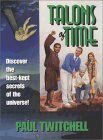

| Talons of Time. By Paul Twitchell. Compiled and adapted by Mar Amongo. Edited by Harold Klemp and Joan Klemp. Minneapolis, MN: Eckankar, 1999. 101p. $14.00. ISBN 1-57043-147-7. |

|
GENRES: AUDIENCE: SYNOPSIS: On the planet, they meet with Arcturans who keep their bodies safe while their souls cross over to S.P. They have little trouble eluding the Tiger guardian, but Laos, the Tiger's mate, is more trouble, and she attempts to seduce Peddar. But Sharir defeats her and forces her to act as their guide. They travel to a village where odd-looking people continually worship Kal Niranjan, and they meet with a solitary rebel leader, who promises to call the rebel magicians together to fight K.N. Later, the little party goes to free John Skally, but Peddar and Laos are captured and imprisoned together. After a series of dreams, Peddar is able to martial enough mental strength to free himself and Laos. He spends a good part of the rest of the story dreaming [it's very hard to tell when the dreams stop, if they ever do, and "reality" intrudes], but he eventually confronts K.N. and finds the missing diary. Laos and Peddar are in love, but Laos is ultimately killed, and the reunited humans hold back the Talons of Time (a single monster) to return the diary to Earth. The synopsis makes this book seem far more coherent than it actually is. It's crammed to the brim with Eck philosophy; practically every statement a character makes has something to do with Eck, and the characters spend a great deal of time explaining these tenets to one another or to the reader. The final third of the book is almost entirely Eck philosophy. EVALUATION: Talons of Time is hilariously bad. When the book doesn't stop dead for sermonizing--and well over 60% of the book is sermonizing--it's telling a story loaded with incongruities and absurdities, with characters no deeper or more appealing than the thickness of the paper they're drawn on. For example, in the early part of the story Twitchell makes much of the fish bowl in John Skally's house (Peddar looks through the window and notes in a line worthy of Ed Wood that "His leather books appear to be the same, but that fishbowl is blazing in wild colors."), but no one considers that a signal of anything. Laos is an "android" for some unknown reason, and her love affair with Peddar makes no sense at all, since he shook off her spell and she did nothing to warrant love after that. None of the nonhuman inhabitants of S.P. seem to care about the different appearance of the humans moving among them. The villagers themselves know that Laos is the "Tiger's mate," but their leaders "were surprised to learn that Laos was the Tiger's mate." Eh? There are many more instances like this. The most annoying section concerned how women are instruments of evil that distract and dominate men. It's telling that Laos is the only female character in the book, and she's probably an android because somehow that makes her less objectionable as a love interest than a real woman would be. The writing in the ordinary parts of the book is usually adequate, but sometimes the prose was so bad that I thought maybe English was Twitchell's second language (he was born in Kentucky and was, in fact, the founder of Eck). Some of this ineptitude may have been Amongo's and the Klemps' fault; the lettering is dreadfully amateurish, with many missing words and very bad punctuation. (If I'd been this poor an editor I'd've been fired after the first manuscript, but given that Harold Klemp is the current leader of Eck, I doubt anyone dared to criticize him.) But the sermons are little more than deadening gobbledygook to anyone not already initiated into the mysteries of Eck. The book promises that the reader will "discover the best-kept secrets of the universe!", but after reading this book twice I still found the secrets as well-kept as before. Milarepa, another book expounding an exotic philosophy, is considerably more understandable and coherent, proving that it is possible to write about such things without sounding ridiculous. And where Milarepa definitely outclasses Talons of Time is in the art. "Well-known artist" Amongo must be well known for being bad. His art is the worst kind of old-fashioned, static, pulp comics drivel, the sort of stuff that would have been rejected from the original Classics Illustrated series. He often fails to illustrate exciting or picturesque moments, choosing instead to mention them in the narration or dialogue. His cosmic moments are laughable.
I guess hard-core Eck people might want this book, though I'm sure they'd be better off with the original text-only version. No one else on the planet would have any reason to read it, except unfortunate reviewers like myself. (Grumble, grumble... if I wasn't committed to reviewing everything... mutter, mutter.) |
||||||
Return to Rational Magic Home
